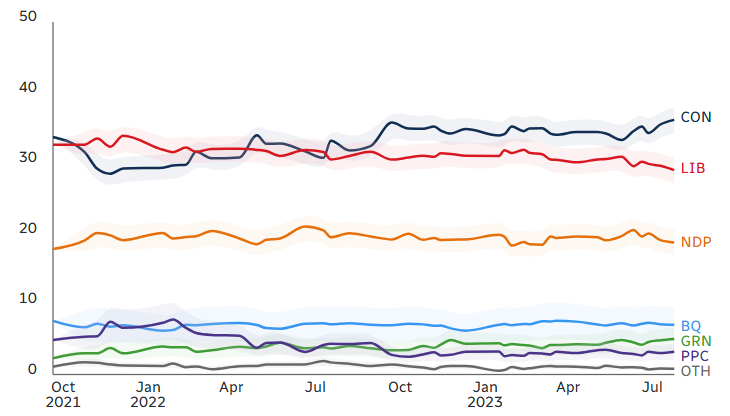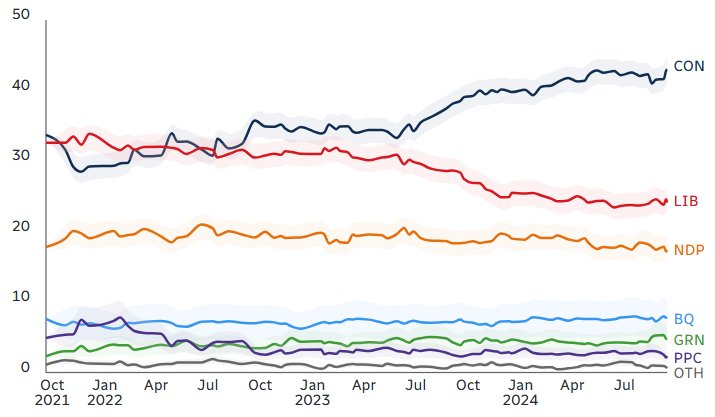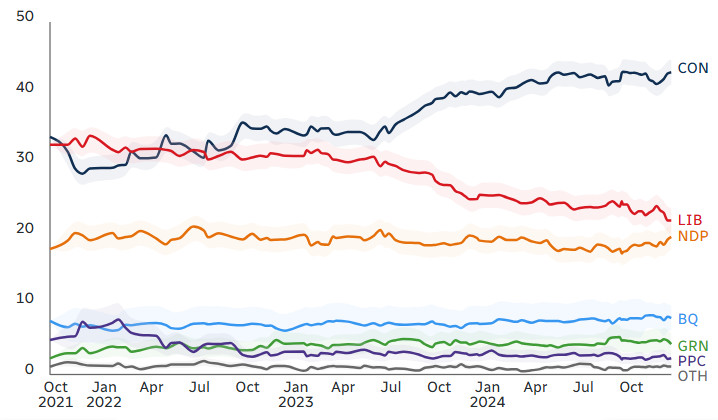Weekly Writ 12/18: After a tough 18 months, will this week end Trudeau?
How the cycle of bad polling and unforced errors has brought the Liberals where they are today.
Welcome to the Weekly Writ, a round-up of the latest federal and provincial polls, election news and political history that lands in your inbox every Wednesday morning.
There’s a lot to unpack this week, so this newsletter may be too long for your email provider. You can expand the email or read it on the website!
Chrystia Freeland’s resignation on Monday, just hours before she was slated to present the government’s fall economic statement, was one of the most remarkable political events in Canadian history.
That might sound like hyperbole — but it isn’t. We’ve rarely seen such a public and withering rebuke of a sitting prime minister at such a vulnerable moment by someone who was seen to be one of that prime minister’s closest allies in cabinet. Brian Mulroney, John Diefenbaker, Mackenzie Bowell come to mind (as they often do) as having suffered significant personal and political blows from cabinet resignations. While the circumstances were different for each of them, none survived much longer as prime minister.
It is hard to imagine how Trudeau can. The coming days might clear matters up, but he seems to have three options available to him, none of them good: he can try to hold on, call an election or resign. The least-bad option for him and his party would seem to be a resignation. A competitive leadership race that names a new prime minister early next year would give the Liberals a fighting (if still long-shot) chance in the next election. By comparison, sacrificing himself on the electoral altar in a snap vote would do little good for the Liberal Party and trying to hold on as prime minister for as long as possible would likely do even more harm.
Whether or not an election now is the right call for the country as a whole is another matter entirely. Depending on how one views what the Conservatives would do once in office, one could debate that Trudeau giving a successor a chance in the next election later is better than handing over the reins of power to Pierre Poilievre now, but it is increasingly untenable for Trudeau to believe that staying on in his weakened state is the better option for Canada, especially in the context of the looming tariff threat south of the border.
Of course, this week’s bombshell didn’t occur in isolation. It’s the culmination of a cycle of series of decisions and events spanning Trudeau’s time in office since 2015 that has been accelerated by the Liberals’ more recent slide in the polls. Attempts to halt that slide resulted in unforced errors, further driving the cycle of bad polls, unforced errors and caucus (and, now, cabinet) unrest.
While the catalyst for the slide might not have explicitly been the cabinet shuffle of July 26, 2023, it certainly seems to have been an inflection point for the government. It was presented as a reset for the Liberals but seemed to many voters to have simply been more of the same.
At the time of the shuffle, the Liberals weren’t in dire straits. Here is where my Poll Tracker pegged things the day before the shuffle:
The Conservatives had opened up a small lead over the Liberals of seven percentage points, but Trudeau was still competitive. The model gave him a 22% chance of winning an election. Those odds had been as high as 45% only the month before. The projection at the time still awarded the Liberals 124 seats against 158 for the Conservatives — far from an insurmountable margin. A successful cabinet shuffle might have done the trick.
But it didn’t. Over the following weeks, the Conservatives rose inexorably in the polls.
By October, the Conservatives had moved ahead by 13 points in national polling, hitting 40% support in the average for the first time. The Liberals were now further behind the Conservatives than they were ahead of the New Democrats, who were just 8.5 points behind. The odds of a Liberal victory had dropped to 4% and the seat projection awarded a majority government to the Conservatives and just 99 seats to the Liberals.
The Liberals were sliding everywhere, including in Atlantic Canada. The party had been favoured to win most of the seats in the region in July. By mid-October, two-thirds of the Liberals’ holdings in Atlantic Canada were at risk.
On October 26, Trudeau announced a carbon tax carve-out for home heating oil. While this impacted more people outside of Atlantic Canada than it did inside the region, Atlantic Canadians were disproportionately the beneficiaries of the carve-out. Meant to show flexibility on the unpopular carbon tax and help the Liberals’ fortunes in one of its core regions of support, instead it suggested incoherence by the government on one of its landmark policies and signalled desperation. The Liberals’ numbers didn’t improve.
By the next spring, the Liberals faced a byelection test in Toronto–St. Paul’s. A stronghold that even survived the 2011 debacle, Toronto–St. Paul’s wasn’t supposed to be all that much of a test. But the polls by now had swung hard against the Liberals.
The Conservative lead had grown to 19 points. The NDP hadn’t enjoyed an uptick, but the continuing Liberal slide had narrowed the gap between it and the Liberals to only seven points. The seat projection had the Liberals down to 63 seats and their chances of re-election at a mere 1%. The Conservatives, meanwhile, had crested 200 seats in the projection in March.
The loss in Toronto–St. Paul’s was the first major, undeniable defeat the Trudeau Liberals had suffered. Some caucus members were grumbling, but a full-on revolt never materialized.
That the polls stabilized over the summer might have helped Trudeau weather the storm. By September 16, when Parliament returned from its summer break, the Conservatives were still 19 points ahead of the Liberals, the NDP still seven points behind. Jagmeet Singh had ended the confidence-and-supply agreement between his party and the government, but it hadn’t moved his own numbers, let alone impact the Liberals’.
But September 16 was also the date of two byelections — one of them in the Montreal riding of LaSalle–Émard–Verdun. Another stronghold, the Liberals this time learned their lesson and lowered expectations. They weren’t lowered enough, however, and the Liberals lost the seat to the Bloc in stunning upset.
Again, caucus grumbled, a little more publicly this time. But Trudeau wasn’t toppled. A new campaign manager was brought in and a new plan for the future was promised. The fall economic statement would be the springboard to better things in 2025.
The loss in LaSalle–Émard–Verdun and the caucus unrest sapped the already-weakened Liberal government. Looking for something to move the dial, Trudeau promised a GST holiday and $250 cheques in the new year, promises that didn’t boost their polls but contributed to Freeland’s resignation. The dream of bringing in Mark Carney to turn things around might have been the final straw.
Before Monday’s events, the Conservatives were ahead by 21 points, the NDP behind the Liberals by just two. The Liberals’ chances of re-election were less than 1% and the seat projection gave them 50 seats, with a lower range that dipped below the upper ranges for both the Bloc Québécois and New Democrats. On Tuesday, Abacus Data published fresh numbers that suggest the Liberals might not have yet hit their floor.
Looking at these longer-term trends, it’s clear that Trudeau’s options were getting worse and fewer with every passing day. The ideal window for a handover came and went — multiple times. Today, no good options remain for the prime minister. Which of the bad ones will he choose?
Programming note: This will be the last Weekly Writ of 2024! The Wednesday newsletter will be back on Jan. 8, 2025 but there will be other newsletters and podcasts published between now and then — especially if there is breaking news!
Now, to what is in this final instalment of the Weekly Writ for the year:
News on the Conservatives’ thumping win in Cloverdale–Langley City and the provincial byelection being held in Alberta, plus Rachel Notley gives up her seat and the B.C. NDP makes a deal with the Greens.
Polls show which premiers are up and which ones are down. Manitoba’s Wab Kinew is definitely up, as shown by a new voting intentions poll out of the province. There’s also some new data on what went down in the series of provincial elections this fall.
A re-elected and bigger NDP majority for Wab Kinew if the election were held today.
Manitoba’s history-making premier in the #EveryElectionProject.
Upcoming milestone for Tim Houston.







